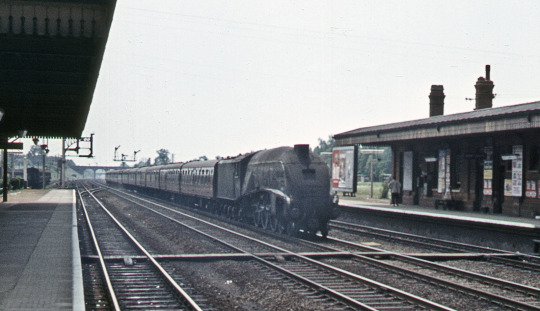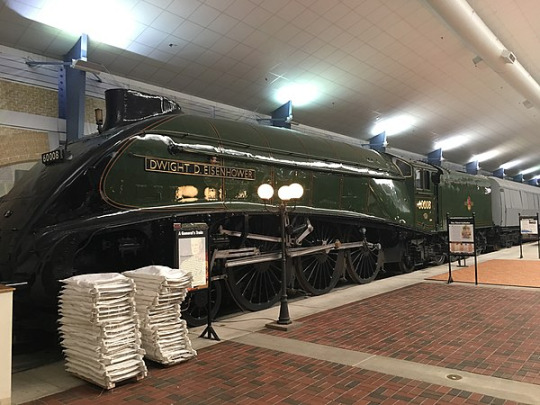#lner w1
Explore tagged Tumblr posts
Note

What are they doing?
They're express engines. They're discussing the state of the railway (gossiping)
but fun thing, there are only 4 A4s here
far right isn't an A4, it's Hush Hush

yep, the LNER's rebuilt white elephant. By all acounts I've found, post rebuild she was just a non-standard A4. Although it is worth noting Gresley was considing rebuild the A4s with the boiler fit to no.10000, so he was impressed with that at part of the rebuild at least.
heading left, we have Golden Eagle

Empire of India (my beloved)

Golden Shuttle, who was later renamed Dwight D. Eisenhower and Preserved

and Dominion of New Zealand

#Hazel Asks#Ask Hazel#Hazel Q&A#LNER#London North Eastern Railway#LNER A4#LNER W1#4-6-2#4-6-4#A4 Pacific
36 notes
·
View notes
Text

Hornby's models of the unique LNER W1 Baltic. Neat that they do the locomotive in both it's original water-tube boiler form and it's later rebuilt form.
1 note
·
View note
Text
Alternative Basis Ideas
So, let’s talk. The non British engines like Hank and Philip, I’ve recently been thinking. How can these characters feasibly work on Sodor, and still fit the loading gauge? So, I’d like to propose some alternatives.
But before I start talking about the characters, here are some rules I’ve set for myself.
Rule 1: if possible, they must have the same wheel arrangement as in canon. Rule 2: they must be an engine built in Britain, or was shipped over to Britain.
–
Canonically, Hank is a Pennsylvania Railroad K4. But seeing as the K4 is too large to run in Britain, what if Hank’s basis was changed to a USATC S160?
–
Another engine I’d like to talk about is Hiro. Hiro is a JNR D51, but this poses a problem. The J51 was built to run on meter gauge, whereas Sodor is standard gauge. So for those of you who adhere to TVS canon and don’t want to change his wheel arrangement/name, i’d like to propose some alternative basis ideas.
Idea 1: Hiro’s new basis is an LNER P1 2-8-2. Idea 2: Hiro is 3045 Hirondelle, a GWR Dean Single. Idea 3: Hiro is 1023 Hirola, a Thompson B1.
–
Next up is Victor. The problem with Victor is that he’s narrow gauge, while the engine he’s based on is standard gauge. To rectify this, I changed his basis to a Great Eastern Railway B74.
–
Now to address the elephant in the room, Bash, Dash, and Ferdinand. I know that these characters are controversial, and not well liked by the fandom. To be honest, I don’t really care for them either, but I might as well get them out of the way.
Bash and Dash are both geared steam locomotives. Specifically, a Gypsy. But seeing as only one of these locomotives still operates, the new basis for Bash and Dash is the Midland Railway 1528 Class.
–
And now for Ferdinand. In the show, Ferdinand’s basis is a Class C Climax. But I’m disregarding that. Ferdinand’s new basis is an LMS Garratt. Specifically, N° 47972, who stalled while banking the LNER U1 and had to be rescued by 58100.
–
Regarding Porter, he’s one of the USA Tanks used at Southampton Docks. But unlike Rosie, who was built by Vulcan, he would be one of two examples built by H. K. Porter, hence his name.
–
As mentioned above with Hank, Connor and Caitlin wouldn’t fit the British loading gauge. So here are some possible ideas for them. Have the LNER W1 be Connor’s basis, and have the LMS Princess Coronation be Caitlin’s basis. Or make them both Princess Coronations.
–
In Tale of The Brave, Timothy’s basis is an oil burning tank engine. But here’s some possible alternate basis ideas, assuming they’ll fit beneath the bridge to the Clay Pits.
Idea 1: LSWR S14 Timothy Idea 2: LSWR B4 Timothy
–
Speaking of Tale of The Brave, now it’s time to talk about Gator. Gator is based on one of the Columbian Steam Motors, but I envision him as either a Midland Railway 2000 Class, or a GNR J23. Personally, I’m leaning more towards the latter because the tanks slope downwards.
–
Oh boy, Sam. Realistically, his basis being the 2-6-6-6 Blue Ridge doesn’t work. Unless Sodor/England somehow upgraded their infrastructure to accommodate engines of his size, he wouldn’t be able to run, period. And so, there’s only one way that Sam can be a large engine, and still fit the loading gauge, have his basis be the LNER U1.
–
And now it’s Philip’s turn. I know Philip is also a controversial character, and not many fans like him, but I figured I should talk about him anyway. As with Hank, Philip is also based on an engine from the Pennsylvania Railroad. But I feel that his basis should be a British Rail Class O2.
–
Lexi is another character whose basis doesn’t make much sense, but for different reasons. The engine Lexi’s based on would have long since been scrapped by the time of JBS, so I propose that her basis should be changed to an SECR E Class.
–
Finishing off this post, is Nia. As with a couple other characters mentioned earlier, Nia is rather, divisive. But I don’t really want to delve too deep into that, so here’s my take on Nia. In canon, she’s an ED1 tank engine from the Kenya-Uganda Railway. But as with Hiro, her basis is meter gauge, so she wouldn’t be able to run on Sodor. To get around this, she’s now an LNER Class V1.
–
Whew, I wasn’t expecting this post to get so long. But that’s what happens when the words keep flowing. None of this is canon to the show, these are just my ideas on what the characters should be. If anyone wants to incorporate things from this post for their own AU, go right ahead. Anyway, that’s enough rambling from me.
1 note
·
View note
Note
Green Arrow, do you know why the other LNER engines hate the W1 so much? (Also, you're my favorite.)
Green Arrow: Other engines opinions of you essentially comes down to how you performed and more importantly how Sir Gresley percieved you. A lot of the engines on the Flying Scotsman's express prided themselves on certain values and that was to perform well, look spotless and be affable and pleasant to passengers. (Why Great Northern worked on the line I have no idea).
The Hush Hush was considered bulky and ugly, ignored passengers and was considered a failure by the Gresley himself and so they where very much outcast because of it and 'Galloping Sausage' became a nasty nickname for it.
You don't ignore passengers on the Flying Scotsman Line. It's just not accepted. Passenger hospitality is their number one concern.
The Flying Scotsman line was like the celebrity line of the LNER. Engines strived to be on it and if you were rejected from by either the engines or the directors, like the W1 was, then you were effectively doomed.
So there was a lot of reasons why W1 was never liked.
(Nice to know someone has TASTE!)

28 notes
·
View notes
Text

oh boy i really have been dead here’s an LNER W1 class
#lner w1#art#trains#w1 class#lner w1 class#hush hush#hush-hush#lner 10000#galloping sausage#high pressure steam locomotive
3 notes
·
View notes
Text
since im bored an because i want ill tallk a small bit about an oc i have.
his name is river. his class is the lner w1. he atleast for rght now resieds in an Edinburgh scrap yard. he dosen't have a tender. he is lacking 4 of his 6 driving wheels and lacking his streamlining and his cupling rods were scaped into bean tins.
the scraers slowly scrap him i there free time when they aren't doing other important things. and that all i have sadly since im not the best with story idea's.
2 notes
·
View notes
Text

G a l l o p i n g S a u s a g e
11 notes
·
View notes
Photo

The LNER W1 No. 10000 (also known as the Hush-Hush due to its secrecy) was an experimental steam locomotive fitted with a high pressure water-tube boiler.
8 notes
·
View notes
Note
The Engine i know for sure as being nicknamed Galloping sausage was the LNER Class W1, the aforementioned experimental high pressure steam engine. Even wikipeida lists the “ Galloping Sausage” nickname and a few other sources confirm it. I got the idea behind the headcanon when I found out about the Engine from train of thought’s video on the subject: .
youtube
I now love Audrey’s railway series more for using this little bit of trivia as a plot point.
Broke Headcanon: Gordon does not like being called a galloping sausage because it's rude. Woke headcanon: galloping sausage was the nickname of a high pressure steam engine prototype designed by Nigel Gresley, it was a failure and so had it's boiler scrapped to be built as a normal engine. So calling Gordon a "galloping sausage" is saying "Your a failed prototype, and I hope you get scrapped!"
I can certainly believe that there were some pretty heavy dimensions to everything Diesel said and did in that arc!
If I understand right, "galloping sausage" is a nickname heard on real-life rails for various engines, though I don't have any sources or know which classes might have earned this badge of shame.
23 notes
·
View notes
Text

Tomorrow is @tigerhawk7109 's birthday, so to celebrate, here is their baby. The LNER W1 Class No. 10000 "Hush Hush"
18 notes
·
View notes
Photo

The LNER (London North Eastern Railways) 4-6-4 Class W1 No.10.000 steam tender locomotive with A4-style streamlining designed by Sir Nigel Gresley steams out of King’s Cross station alongside the LNER Class A4 No.4
0 notes